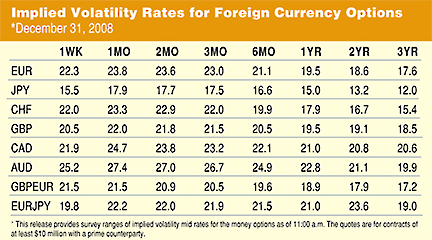FOREX FOCUS
Which Way For The Forex Carry Trade?
Apply this very popular trading strategy to 2009 trades.
The foreign exchange carry trade has been a popular trading strategy for the past 10 years due to growing economies and rising interest rates. This period of world growth was precipitated by the last economic downturn in world economies (1998) that lasted approximately two years. Currently, with a credit crunch upon us and recession gripping world economies in late 2008 and forecast to last well into 2009, all nations are in the process of slashing interest rates. Where does that leave this most popular and profitable of trading strategies? In this article, I will examine the carry trade, its definition, its uses, its purposes, and a compendium of possibilities for 2009.
The carry trade
The carry trade, more commonly known as the crosses, is a simple and popular trading strategy in the currency market. This trade involves buying a high-yielding/high interest rate currency and selling a low-yielding/low interest rate currency. For many years, the Japanese yen has been the most favored carry trade strategy because of its traditionally low or no interest rate governmental policy. By matching the yen with a high-yielding currency from a growing economy, you can earn interest on a daily basis because of the difference in yield. By choosing a nation coming out of a recession and on its way to solid long-term growth with the possibility of rising interest rates, you can earn years of yield credited on a daily basis.
For example, since the last world recession, New Zealand has had a growing economy with a steady increase in interest rates. At one point in 2008, New Zealand achieved an interest rate of 8%. By matching the New Zealand dollar (better known as the kiwi) with the yen, which traditionally has had a zero interest rate policy — that is, trade the Nzd/Jpy — you can use the carry trade effectively to earn a large return on interest with the intention to also earn capital appreciation on this trade from a growing economy.
Many other popular and profitable yen strategies have existed over the years, such as Australian dollar/yen (Aud/Jpy), sterling/yen (Gbp/Jpy), Canadian dollar/yen (Cad/Jpy), euro/yen (Eur/Jpy) and Swiss franc/yen (Chf/Jpy). All economies of the seven majors have had solid growth with rising interest rates for many years, a boon for the carry trade due to the raising of interest rates into inflation.

Figure 1: implied volatility rates. The implied volatility rates are averages of mid-level rates for bid and ask “at-money” quotations on selected currencies at 11:00 am on the last business day of the month.
Besides the yen, there are many other combinations for the carry trade such as Gbp/Chf, Eur/Chf, Aud/Cad, Eur/Gbp, and more. The Eur/Gbp must be evaluated for the positive interest to determine if a long or short position would be best as these two currencies move in the same direction as the Eur/Usd and Gbp/Usd.